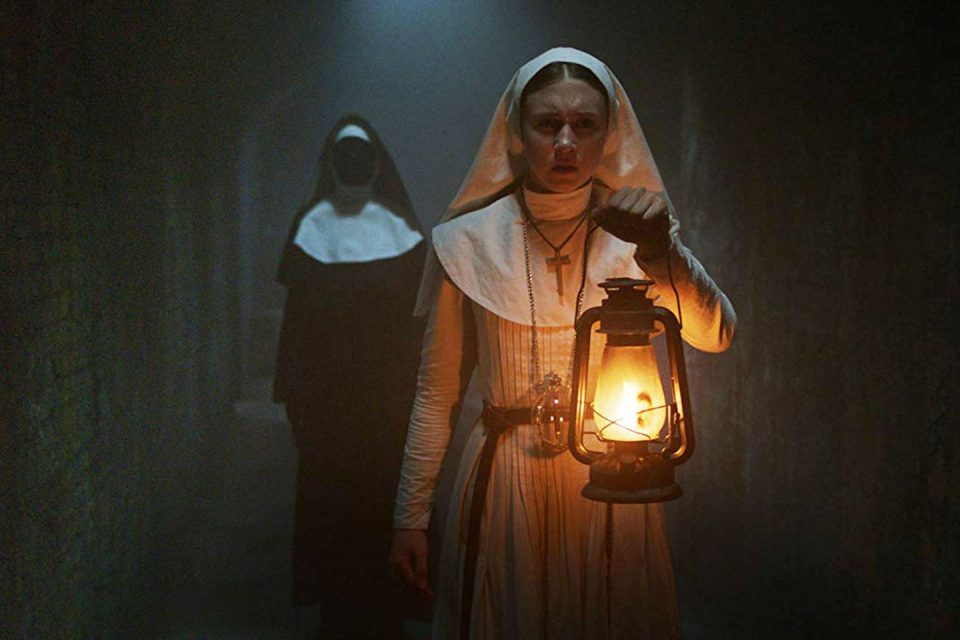‘The Nun’ Review: ‘Conjuring’ Prequel Is an Unholy Mess
Latest entry of the horror franchise aims for some ol’ time religious scares and comes up empty
★★½
The twisted magic of the original Conjuring movie seems awfully distant these days, doesn’t it? In James Wan’s 2013 horror hit about a big blue collar family being tormented by an ancient demon, old-fashioned jump scares and a relentless sense of dread mixed expertly with a deeply human story; the fact that we cared about the characters made the chills that much more affecting (and that much more effective). Despite the studio budget, that ghost story possessed an elegant simplicity as well, with Wan fashioning one of the most disturbing scenes in modern horror: A simple image of a young girl staring at the patch of darkness behind her bedroom door, insisting that there was someone right there. It wasn’t so much the darkness that sold the scene; it was the girl’s face, and the absolute, teary-eyed terror it conveyed. Since then, however, this horror franchise has added spin-offs (see: the Annabelle films) and doubled down on the jump scares and genre pyrotechnics. Worse, it’s forsaken the people. Each new entry feels a little more insistent, overdetermined and soulless.
Set in 1952, The Nun purports to be a prequel to the demonic shenanigans of the earlier Conjuring-verse movies ”” and it starts off promisingly enough. Two nuns at the Romanian Abbey of St. Carta confront a demonic presence in a forbidden corner of the ancient building. (There’s even a sign marked “God ends here.”) One is consumed by the darkness; the other hangs herself off the side of the abbey to prevent this mysterious evil from finding a host in her body. Experienced priest Father Burke (Demian Bichir) is called by the Vatican to investigate, and because it’s a convent, he’s assigned a partner of sorts in young novitiate Sister Irene (Taissa Farmiga, the young sibling of Conjuring star Vera Farmiga), who has been touched by a variety of religious visions over the years. The duo head to Biertan, Romania, and meet up with a local peasant known as “Frenchie” (Jonas Bloquet), who discovered the corpse. Their attempts to investigate the young woman’s death are complicated by the fact that everyone is acting strangely: They scurry mysteriously in corners and rarely talk. Even the Abbess herself, whose face we never see, only speaks in an ominous creak from behind a dark veil.
Initially, the movie’s gathering sense of menace and director Corin Hardy’s evocative use of the Romanian setting (with lots of craggy, mountainous vistas and ominous shots of the sky) feel like a welcome throwback to Wan’s original. But tragically, we get little sense of these central characters ”” which seems like a missed opportunity, as there are only three of them, and 90 whole minutes of movie to fill. Father Burke feels remorse over a wartime exorcism he conducted on a young boy, but the film does almost nothing with his regret; the child simply becomes another supernatural cliché pursuing our hero through the halls of the abbey. Something similar happens with Sister Irene’s visions, which contain an obvious and pointless clue to be revealed near the end of the film (when they could have revealed something about this young woman’s character instead). Meanwhile, we’re told the abbey was bombed during World War II, and that this may well have something to do with the evils now emerging ”” a potentially resonant idea that here becomes just another cheap narrative convenience.
The creepy, somber mood, so expertly established in The Nun”˜s early scenes, doesn’t last either: Once everyone gets to the abbey, the film simply gives up the ghost and cynically indulges every horror trick in the book. Hands burst through doors and grab people; crosses magically turn upside down; nuns go flying or are set aflame. Along the way, we are inundated with creepy reflections and figures plunging out of the darkness and, of course, those obligatory oh-god-what’s-that-over-your-shoulder shots. A little of this stuff goes a long way, and a lot of this stuff doesn’t go very long at all. True horror requires anticipation to work properly, but it’s hard to anticipate anything when everything’s already being thrown at us. The dread dissipates. Our screams become nothing but weary sighs.





